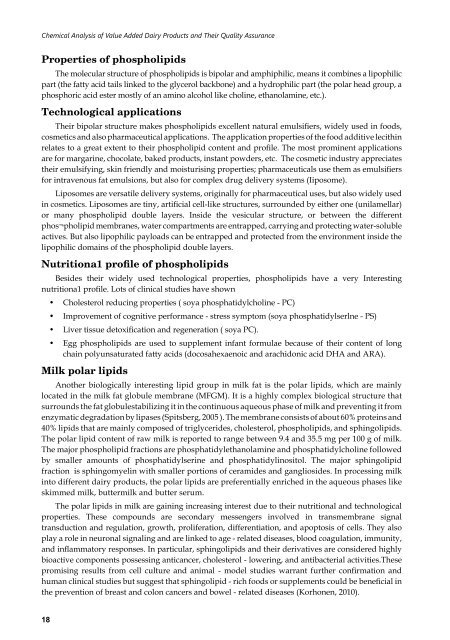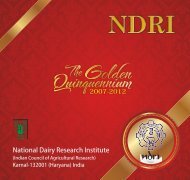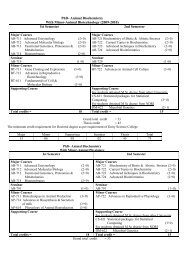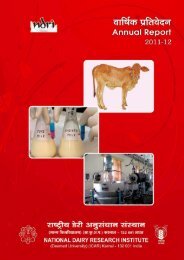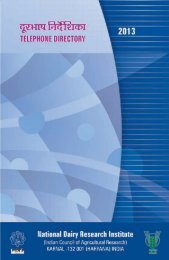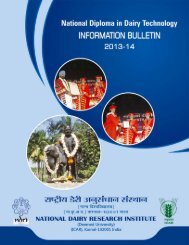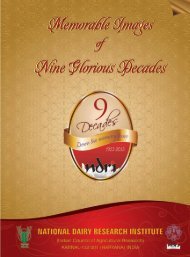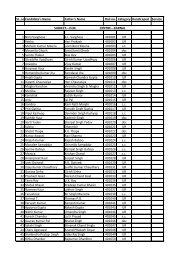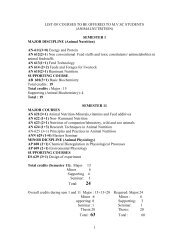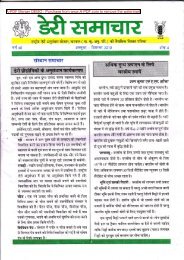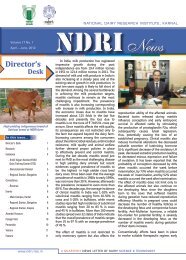Chemical Analysis of Value Added Dairy Products and Their Quality ...
Chemical Analysis of Value Added Dairy Products and Their Quality ...
Chemical Analysis of Value Added Dairy Products and Their Quality ...
You also want an ePaper? Increase the reach of your titles
YUMPU automatically turns print PDFs into web optimized ePapers that Google loves.
<strong>Chemical</strong> <strong>Analysis</strong> <strong>of</strong> <strong>Value</strong> <strong>Added</strong> <strong>Dairy</strong> <strong>Products</strong> <strong>and</strong> <strong>Their</strong> <strong>Quality</strong> AssuranceProperties <strong>of</strong> phospholipidsThe molecular structure <strong>of</strong> phospholipids is bipolar <strong>and</strong> amphiphilic, means it combines a lipophilicpart (the fatty acid tails linked to the glycerol backbone) <strong>and</strong> a hydrophilic part (the polar head group, aphosphoric acid ester mostly <strong>of</strong> an amino alcohol like choline, ethanolamine, etc.).Technological applications<strong>Their</strong> bipolar structure makes phospholipids excellent natural emulsifiers, widely used in foods,cosmetics <strong>and</strong> also pharmaceutical applications. The application properties <strong>of</strong> the food additive lecithinrelates to a great extent to their phospholipid content <strong>and</strong> pr<strong>of</strong>ile. The most prominent applicationsare for margarine, chocolate, baked products, instant powders, etc. The cosmetic industry appreciatestheir emulsifying, skin friendly <strong>and</strong> moisturising properties; pharmaceuticals use them as emulsifiersfor intravenous fat emulsions, but also for complex drug delivery systems (Iiposome).Liposomes are versatile delivery systems, originally for pharmaceutical uses, but also widely usedin cosmetics. Liposomes are tiny, artificial cell-like structures, surrounded by either one (unilamellar)or many phospholipid double layers. Inside the vesicular structure, or between the differentphos¬pholipid membranes, water compartments are entrapped, carrying <strong>and</strong> protecting water-solubleactives. But also lipophilic payloads can be entrapped <strong>and</strong> protected from the environment inside thelipophilic domains <strong>of</strong> the phospholipid double layers.Nutritiona1 pr<strong>of</strong>ile <strong>of</strong> phospholipidsBesides their widely used technological properties, phospholipids have a very Interestingnutritiona1 pr<strong>of</strong>ile. Lots <strong>of</strong> clinical studies have shown• Cholesterol reducing properties ( soya phosphatidylcholine - PC)• Improvement <strong>of</strong> cognitive performance - stress symptom (soya phosphatidylserlne - PS)• Liver tissue detoxification <strong>and</strong> regeneration ( soya PC).• Egg phospholipids are used to supplement infant formulae because <strong>of</strong> their content <strong>of</strong> longchain polyunsaturated fatty acids (docosahexaenoic <strong>and</strong> arachidonic acid DHA <strong>and</strong> ARA).Milk polar lipidsAnother biologically interesting lipid group in milk fat is the polar lipids, which are mainlylocated in the milk fat globule membrane (MFGM). It is a highly complex biological structure thatsurrounds the fat globulestabilizing it in the continuous aqueous phase <strong>of</strong> milk <strong>and</strong> preventing it fromenzymatic degradation by lipases (Spitsberg, 2005 ). The membrane consists <strong>of</strong> about 60% proteins <strong>and</strong>40% lipids that are mainly composed <strong>of</strong> triglycerides, cholesterol, phospholipids, <strong>and</strong> sphingolipids.The polar lipid content <strong>of</strong> raw milk is reported to range between 9.4 <strong>and</strong> 35.5 mg per 100 g <strong>of</strong> milk.The major phospholipid fractions are phosphatidylethanolamine <strong>and</strong> phosphatidylcholine followedby smaller amounts <strong>of</strong> phosphatidylserine <strong>and</strong> phosphatidylinositol. The major sphingolipidfraction is sphingomyelin with smaller portions <strong>of</strong> ceramides <strong>and</strong> gangliosides. In processing milkinto different dairy products, the polar lipids are preferentially enriched in the aqueous phases likeskimmed milk, buttermilk <strong>and</strong> butter serum.The polar lipids in milk are gaining increasing interest due to their nutritional <strong>and</strong> technologicalproperties. These compounds are secondary messengers involved in transmembrane signaltransduction <strong>and</strong> regulation, growth, proliferation, differentiation, <strong>and</strong> apoptosis <strong>of</strong> cells. They alsoplay a role in neuronal signaling <strong>and</strong> are linked to age - related diseases, blood coagulation, immunity,<strong>and</strong> inflammatory responses. In particular, sphingolipids <strong>and</strong> their derivatives are considered highlybioactive components possessing anticancer, cholesterol - lowering, <strong>and</strong> antibacterial activities.Thesepromising results from cell culture <strong>and</strong> animal - model studies warrant further confirmation <strong>and</strong>human clinical studies but suggest that sphingolipid - rich foods or supplements could be beneficial inthe prevention <strong>of</strong> breast <strong>and</strong> colon cancers <strong>and</strong> bowel - related diseases (Korhonen, 2010).18


